James Rada, Jr.
When Joyce Bruchey was a senior at Emmitsburg High School in 1962, the principal came into her class and asked her and another student to substitute teach in the first-grade class. It was an experience that changed her life.
“I had wanted to do something with agriculture, but at that point, I changed what I wanted to do,” Bruchey said.
She became a teacher, and the first school where she was hired was Emmitsburg. However, she was trained in secondary education but hired as a third-grade teacher at the age of 22. She went on to teach in various schools in the county for 39 years. She now serves as the historian for the Emmitsburg High School Alumni Association.
Pointing to the library’s community room, Bruchey said, “It’s been over 70 years since I first sat in that [first grade] room as a student.”
On September 17, one hundred years and two days after the Emmitsburg School first opened, dozens of people gathered at the current Emmitsburg Community Center to celebrate the building’s history.
Frederick County Executive Jan Gardner and Emmitsburg Mayor Don Briggs cut the ribbon for the newest historic wayside marker in town, which recognizes the history of the school. Inside the Emmitsburg Library, visitors viewed a new exhibit about the history of the building and other historic artifacts and pictures Bruchey had brought for the event. They also enjoyed refreshments in the community room as they reminisced about school.
Librarian Penny Stockton created the display hanging on the library wall. She hadn’t realized the building was 100 years old until she was creating a similar display about the history of the Emmitsburg Library.
“This building is important to the people here,” Stockton said. “Look at how they fought to keep the school.”
Many of the attendees were former students at the school, and they spent a lot of time talking about their time in the building as students and teachers, pointing out where classrooms used to be and recalling students and teachers they knew.
The building was originally constructed as the Emmitsburg School in 1922 and housed grades 1-11. The elementary classes were on the first floor, and the high school classes were on the second floor and basement. The only bathroom in the building was also in the basement.
Grade 12 was added to the school in 1949 as part of changes the state made to the education system. A new wing was built that held the cafeteria, gymnasium, and locker rooms between 1950 and 1952.
However, due to a decreasing enrollment, the county-built Catoctin High School in Thurmont in 1969 and combined the student bodies of Emmitsburg and Thurmont into the school.
The last graduating class from Emmitsburg High School was in 1968. Catoctin High opened in the middle of the following school year, and the students were moved to the new school.
The building was adapted as a community center for Emmitsburg and now houses a variety of organizations, including the Emmitsburg town office, the Emmitsburg Library, the Frederick County Department of Parks and Recreation, the Emmitsburg Senior Center, the Frederick County Health Department, the YMCA Head Start, the Catoctin Community Agency School, the Catoctin-Ettes, the Silver Fancy Garden Club, and the Catoctin Youth Association Basketball.
“Without a doubt, this building has served as the heart of the community for 100 years,” Gardner said during her remarks at the celebration.
Photos by James Rada, Jr.
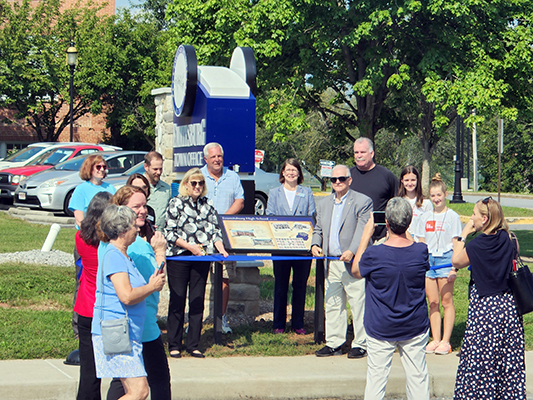
(above) Community members and officials gather for the ribbon cutting of Emmitsburg’s newest wayside marker that depicts the building’s former use as a school.
(below) Memorabilia of the former Emmitsburg High School are shown.
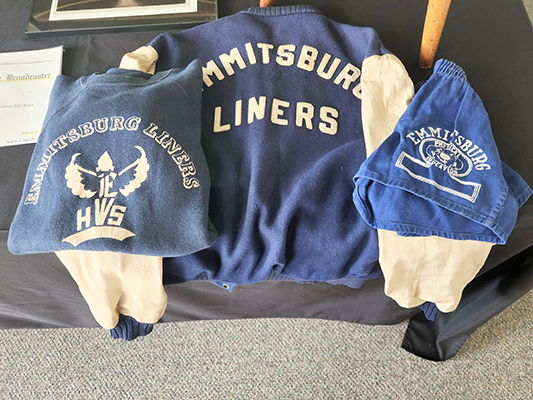

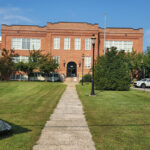
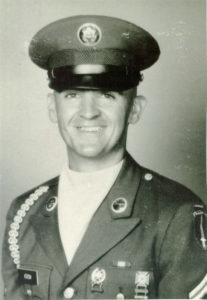 Sergeant Kenneth Lionel Krom
Sergeant Kenneth Lionel Krom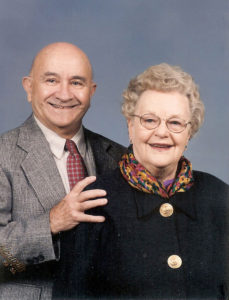 Earl A. Rice, Jr. and Mary (Gene) Eugenia (Matthews) Rice were meant to be together. Some of the family members joke that their marriage was an arranged one. Earl and Gene first met in the backyard of the old Rouzer home in Thurmont, from which, the wall paper, now in the Diplomatic Reception Room of the White House, came. Their mothers—Jessie (Rouzer) Matthews and Helen (Creager) Rice—grew up as next-door neighbors, and were visiting their childhood homes with their first born on the same weekend, sometime in 1924—when someone snapped the above picture. It must have been love at first sight, because they grew up separated by a mountain range and thirty-five miles. They would see each other on occasion during these kinds of weekend visits and dated during their teens and early twenties. They mostly double-dated—the only way Jessie found acceptable—and have many fond memories of those times. Earl sometimes got to borrow his mother’s Lincoln Zephyr, so they got to date in style. Mostly, he came in the Model A that he and his lifelong friend, Henry Steiger, owned together.
Earl A. Rice, Jr. and Mary (Gene) Eugenia (Matthews) Rice were meant to be together. Some of the family members joke that their marriage was an arranged one. Earl and Gene first met in the backyard of the old Rouzer home in Thurmont, from which, the wall paper, now in the Diplomatic Reception Room of the White House, came. Their mothers—Jessie (Rouzer) Matthews and Helen (Creager) Rice—grew up as next-door neighbors, and were visiting their childhood homes with their first born on the same weekend, sometime in 1924—when someone snapped the above picture. It must have been love at first sight, because they grew up separated by a mountain range and thirty-five miles. They would see each other on occasion during these kinds of weekend visits and dated during their teens and early twenties. They mostly double-dated—the only way Jessie found acceptable—and have many fond memories of those times. Earl sometimes got to borrow his mother’s Lincoln Zephyr, so they got to date in style. Mostly, he came in the Model A that he and his lifelong friend, Henry Steiger, owned together.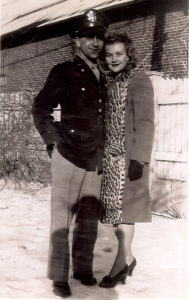 Earl and Gene lived for a time in California, then onto various assignments, including Pecos, Texas, where these East Coast kids had to contend with such things as spiders and West Texas dust storms. Earl and his crew had to travel separately on a troop train, while the wives followed with one of his fellow officer’s mother as a chaperone, another sign of a different time. Gene made some lifelong friends, with many of the wives demonstrating the love that has endeared her to all those around her. Only a short time after their marriage, Earl and his crew were assigned to their B-29 in the South Pacific Island of Tinian. They had to travel on a troop ship to meet up with their aircraft. Gene headed back home.
Earl and Gene lived for a time in California, then onto various assignments, including Pecos, Texas, where these East Coast kids had to contend with such things as spiders and West Texas dust storms. Earl and his crew had to travel separately on a troop train, while the wives followed with one of his fellow officer’s mother as a chaperone, another sign of a different time. Gene made some lifelong friends, with many of the wives demonstrating the love that has endeared her to all those around her. Only a short time after their marriage, Earl and his crew were assigned to their B-29 in the South Pacific Island of Tinian. They had to travel on a troop ship to meet up with their aircraft. Gene headed back home.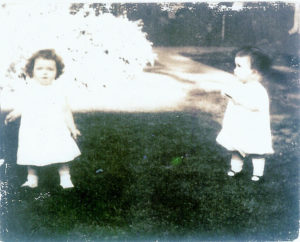
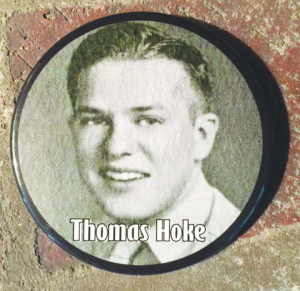 “Some days I wonder if it’s a blessing or a curse to live to be as old as I am,” said
“Some days I wonder if it’s a blessing or a curse to live to be as old as I am,” said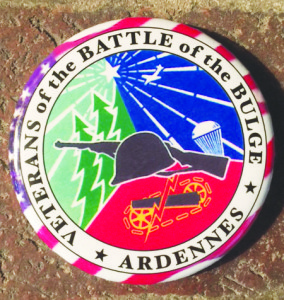 Emmitsburg native and ninety-two-year-old World War II Veteran, Tom Hoke. “I’ve lived plenty of good times and plenty of bad times. I hope, when it’s my time to go, that I go without being a burden on anyone.”
Emmitsburg native and ninety-two-year-old World War II Veteran, Tom Hoke. “I’ve lived plenty of good times and plenty of bad times. I hope, when it’s my time to go, that I go without being a burden on anyone.” 